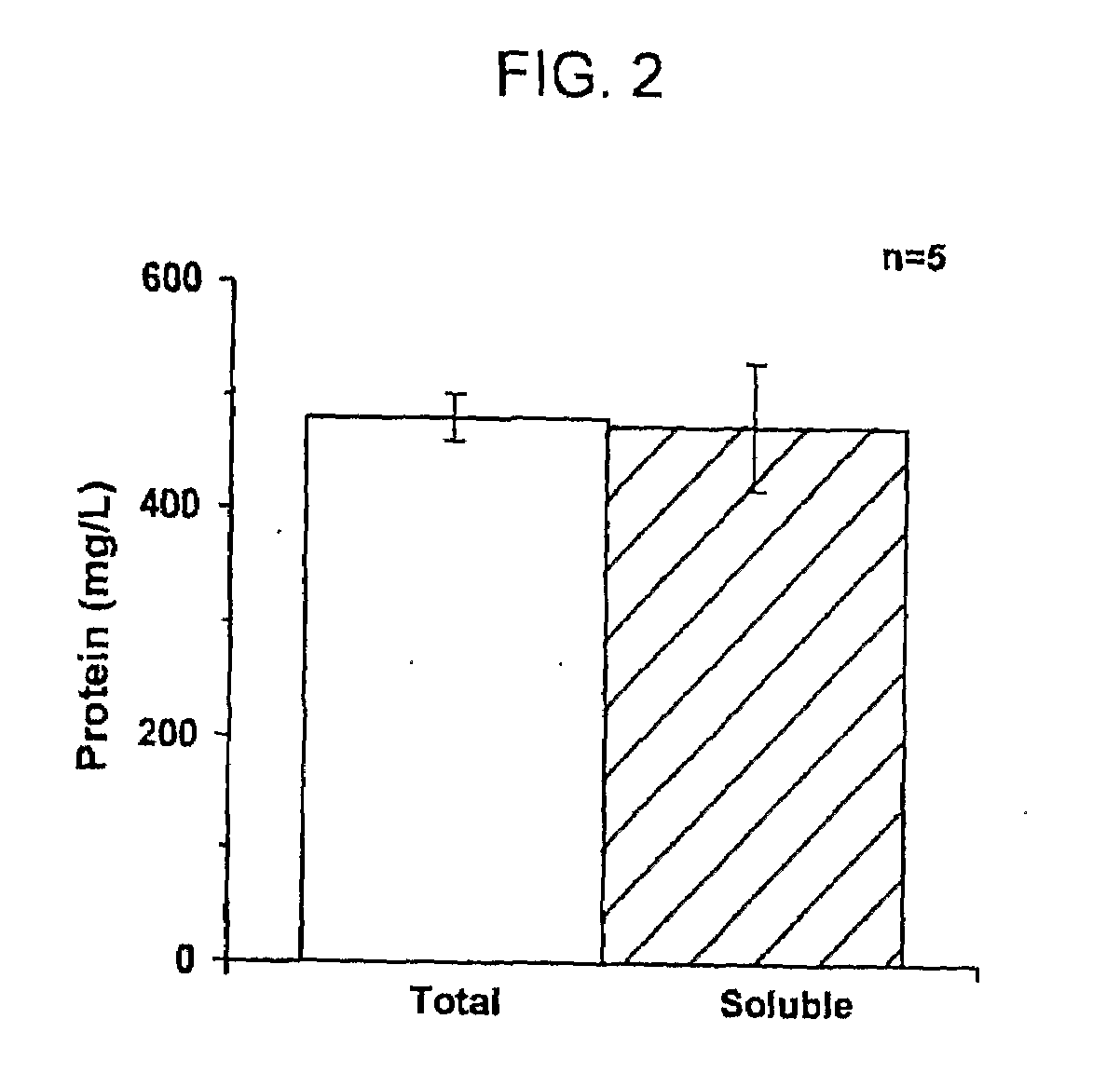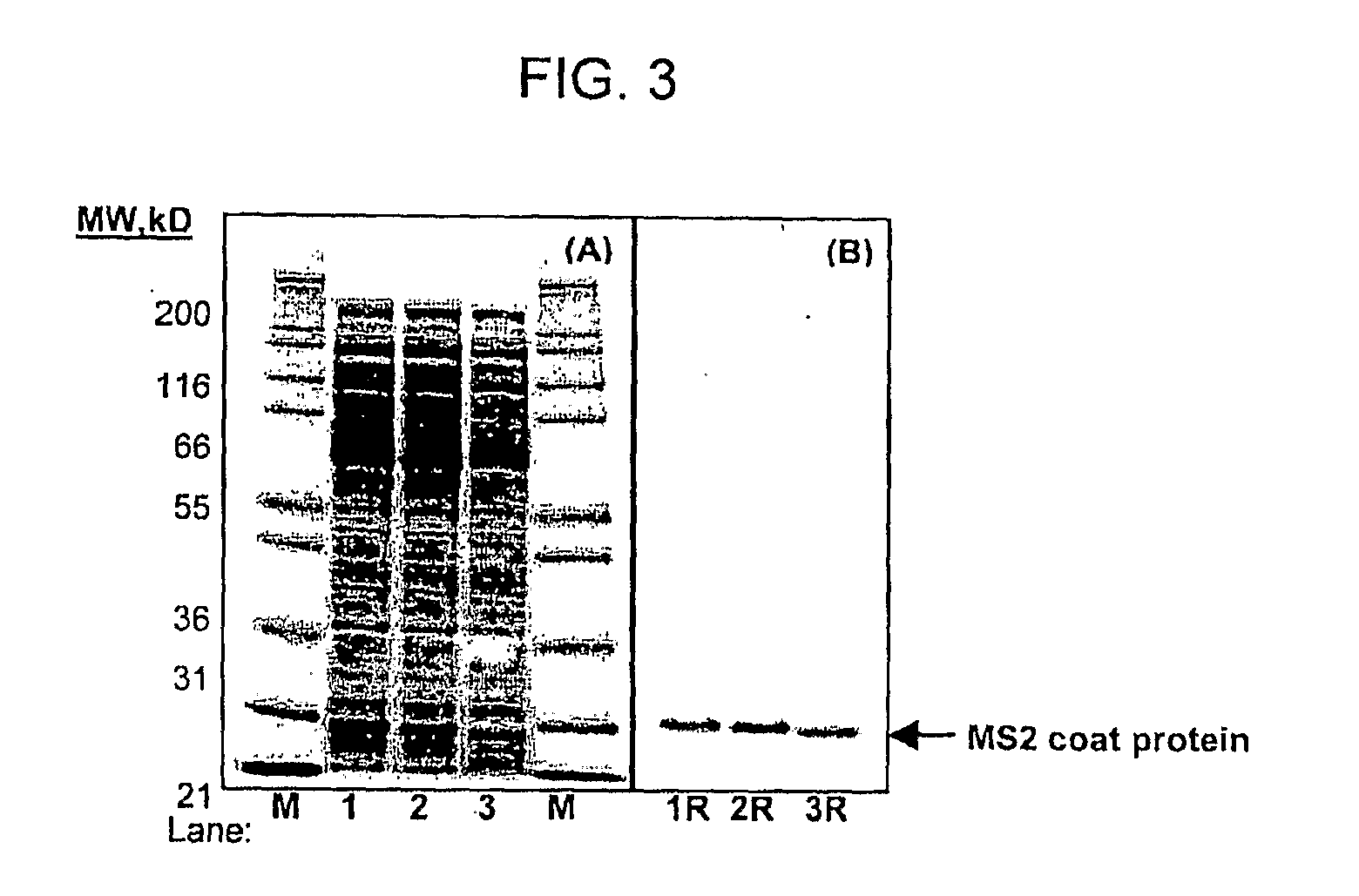Cell-free synthesis of virus like particles
a cell-free, virus-like technology, applied in the field of cell-free synthesis of virus-like particles, can solve the problems of extremely low yield of eukaryotic cell-free systems, and achieve the effect of high yield of assembled nanoparticles
- Summary
- Abstract
- Description
- Claims
- Application Information
AI Technical Summary
Benefits of technology
Problems solved by technology
Method used
Image
Examples
example 1
Synthesis of Optimized MS2 Gene
Materials and Methods
[0060]Plasmid Construction. The MS2 Coat Protein gene was optimized for both E. coli tRNA relative concentrations (preferred codons) and synthesis from oligonucleotides using DNAworks (Hoover D and Lubkowski J, 2002 Nucleic Acids Res 30(10):e43). Oligonucleotides (60 bp average length, Operon Technologies, USA) based on sequences recommended by DNAworks were assembled into the optimized MS2 coat protein gene nucleotide sequence using two-step PCR. pET24a-MS2 cp was generated by ligation (T4 DNA ligase, NEB, USA) of the optimized MS2 coat protein sequence into the pET-24a(+) vector (Novagen, USA) at the NdeI and SalI restriction sites. pET24a-MS2 cp was transformed into DH5α cells (One Shot MAXX Efficiency DH5α-T1R Competent Cells, Invitrogen) and the plasmid was purified with Qiagen Plasmid Maxi Kit (Qiagen, Valencia, Calif.) for use in cell-free protein synthesis. See FIG. 1 for sequence
example 2
Expression of MS2 Coat Protein
Materials and Methods:
[0061]PANOx SP Cell-free Expression System. The PANOx SP system (described in Jewett and Swartz, 2004 Biotechnol Bioeng 86(1):1926) cell-free reactions were 30 μl in volume and were incubated at 37° C. for 3 hr in 1.5 ml eppendorf tubes. The reaction includes the following components: 1.2 mM ATP, 0.85 mM each of GTP, UTP, and CTP, 34 μg / mL folinic acid, 170.6 μg / mL E. coli tRNA mixture, 24 nM plasmid, 100 μg / mLT7 RNA polymerase, 5 μM I-[U-14C] leucine, 2 mM each of 20 unlabeled amino acids, 0.33 mM nicotinamide adenine dinucleotide (NAD), 0.27 mM coenzyme A (CoA), 30 mM phosphoenolpyruvate, 1.5 mM spermidine, 1 mM putrescine, 170 mM potassium glutamate, 10 mM ammonium glutamate, 20 mM magnesium glutamate, 2.7 mM sodium oxalate, and 24% v / v of S30 extract prepared as described (Liu et al., 2005 Biotechnol Prog 21:460-465).
[0062]Protein Yield Determination. Total synthesized protein yields were determined by TCA-precipitation and rad...
example 3
Demonstrating Assembly of MS2 Capsid
[0065]Dialysis. To remove unincorporated L-[U-14C] leucine, the cell-free produced was dialyzed in 6-8000 MWCO Specra / Pro Molecular porous Membrane Tubing (Spectrum Labs) against 300 mL TSM buffer (10 mM Tris-HCl, 100 mM sodium chloride, 1 mM magnesium chloride, pH 7.0) overnight with 2 buffer exchanges.
[0066]Sucrose Step-Gradient Velocity Sedimentation. The dialyzed cell-free reaction product was subjected to sucrose discontinuous gradient centrifugation. Polyallose 16×102 mm Centrifuge Tubes (Beckman, Palo Alto, Calif.) were successively filled with 1 mL each of sucrose solution decreasing by 2.5% w / v (40%, 37.5%, 35%, 32.5%, 30%, 27.5%, 25%, 22.5%, 20%, 17.5%, 15%, 12.5%, 10% w / v) in TSM buffer. The dialyzed cell-free reaction product was layered on top of the tube and centrifugation was performed at 31,000 rpm in a Beckman-Coulter SW-32 swinging bucket rotor (Fullerton, Calif.) in a Beckman L8-M ultracentrifuge at 4° C. for 3.5 hr with “slow” ...
PUM
| Property | Measurement | Unit |
|---|---|---|
| Fraction | aaaaa | aaaaa |
| Density | aaaaa | aaaaa |
Abstract
Description
Claims
Application Information
 Login to View More
Login to View More - R&D
- Intellectual Property
- Life Sciences
- Materials
- Tech Scout
- Unparalleled Data Quality
- Higher Quality Content
- 60% Fewer Hallucinations
Browse by: Latest US Patents, China's latest patents, Technical Efficacy Thesaurus, Application Domain, Technology Topic, Popular Technical Reports.
© 2025 PatSnap. All rights reserved.Legal|Privacy policy|Modern Slavery Act Transparency Statement|Sitemap|About US| Contact US: help@patsnap.com



